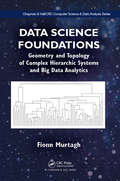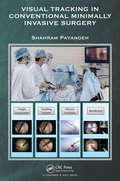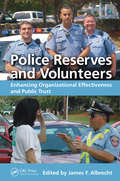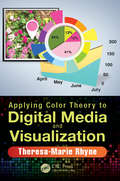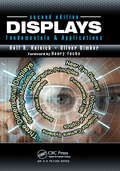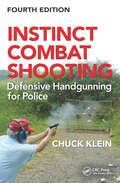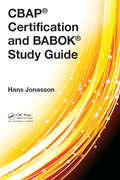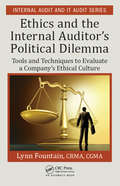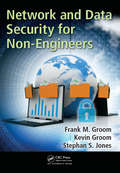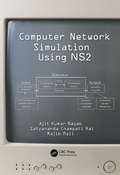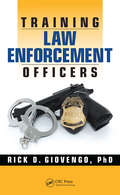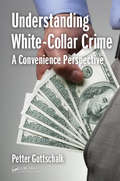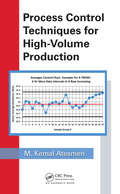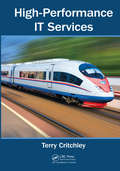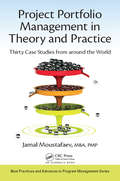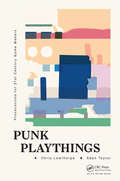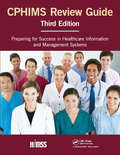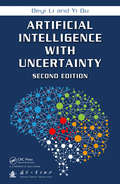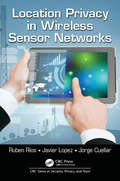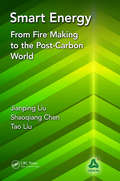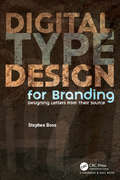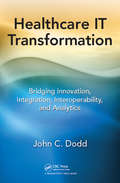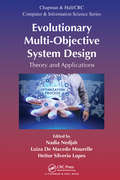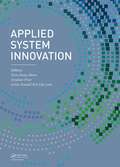- Table View
- List View
Data Science Foundations: Geometry and Topology of Complex Hierarchic Systems and Big Data Analytics (Chapman & Hall/CRC Computer Science & Data Analysis)
by Fionn Murtagh"Data Science Foundations is most welcome and, indeed, a piece of literature that the field is very much in need of…quite different from most data analytics texts which largely ignore foundational concepts and simply present a cookbook of methods…a very useful text and I would certainly use it in my teaching."- Mark Girolami, Warwick University Data Science encompasses the traditional disciplines of mathematics, statistics, data analysis, machine learning, and pattern recognition. This book is designed to provide a new framework for Data Science, based on a solid foundation in mathematics and computational science. It is written in an accessible style, for readers who are engaged with the subject but not necessarily experts in all aspects. It includes a wide range of case studies from diverse fields, and seeks to inspire and motivate the reader with respect to data, associated information, and derived knowledge.
Visual Tracking in Conventional Minimally Invasive Surgery
by Shahram PayandehVisual Tracking in Conventional Minimally Invasive Surgery introduces the various tools and methodologies that can be used to enhance a conventional surgical setup with some degree of automation. The main focus of this book is on methods for tracking surgical tools and how they can be used to assist the surgeon during the surgical operation. Various notions associated with surgeon–computer interfaces and image-guided navigation are explored, with a range of experimental results. The book starts with some basic motivations for minimally invasive surgery and states the various distinctions between robotic and non-robotic (conventional) versions of this procedure. Common components of this type of operation are presented with a review of the literature addressing the automation aspects of such a setup. Examples of tracking results are shown for both motion and gesture recognition of surgical tools, which can be used as part of the surgeon–computer interface. In the case of marker-less tracking, where no special visual markers can be added to the surgical tools, the tracking results are divided into two types of methodology, depending on the nature and the estimate of the visual noise. Details of the tracking methods are presented using standard Kalman filters and particle filters. The last part of the book provides approaches for tracking a region on the surgical scene defined by the surgeon. Examples of how these tracking approaches can be used as part of image-guided navigation are demonstrated. This book is designed for control engineers interested in visual tracking, computer vision researchers and system designers involved with surgical automation, as well as surgeons, biomedical engineers, and robotic researchers.
Police Reserves and Volunteers: Enhancing Organizational Effectiveness and Public Trust
by James F. AlbrechtReductions in police department funding have raised the importance of volunteers in enhancing organizational performance, improving community trust and confidence, and at times accomplishing basic tasks to maintain public safety and security. During a period when police administrators are asked to do more with less, and to engage in smarter, community-oriented policing, citizen volunteers are an invaluable resource. Police Reserves and Volunteers is an invaluable primer for those looking to understand the benefits and challenges involved in the use of the volunteers within global law enforcement agencies. Using cases from a range of specialists and precincts, this edited volume provides a rare window into police administration from the state legislation that regulates police reserves in California to the local models observed in many counties and cities across the United States. Police Reserves and Volunteers offers volunteers, local elected officials, and law enforcement straightforward guidelines to enhance police goals and build public trust in local communities.
Applying Color Theory to Digital Media and Visualization
by Theresa-Marie RhyneThis book provides an overview of the application of color theory concepts to digital media and visualization. It highlights specific color concepts like color harmony and shows how to apply the concept with case study examples and usage of actual online and mobile color tools. Color deficiencies are reviewed and discussed are color tools for examining how a specific color map design will look to someone with the deficiency. Other books on color examine artists' use of color, color management, or color science. This book applies fundamental color concepts to digital media and visualization solutions. It is intended for digital media and visualization content creators and developers. Presents Color Theory Concepts that can be applied to digital media and visualization problems over and over again Offers Comprehensive Review of the Historical Progression of Color Models Demonstrates actual case study implementations of color analyses tools Provides overview of Color Theory and Harmony Analytics in terms of online and mobile analysis tools Teaches the color theory language to use in interacting with color management professionals
Displays: Fundamentals & Applications, Second Edition
by Rolf R. Hainich Oliver BimberIn the extensive fields of optics, holography and virtual reality, technology continues to evolve. Displays: Fundamentals and Applications, Second Edition addresses these updates and discusses how real-time computer graphics and vision enable the application and displays of graphical 2D and 3D content. This book explores in detail these technological developments, as well as the shifting techniques behind projection displays, projector-camera systems, stereoscopic and autostereoscopic displays. This new edition contains many updates and additions reflecting the changes in fast developing areas such as holography and near-eye displays for Augmented and Virtual reality applications. Perfect for the student looking to sharpen their developing skill or the master refining their technique, Rolf Hainich and Oliver Bimber help the reader understand the basics of optics, light modulation, visual perception, display technologies, and computer-generated holography. With almost 500 illustrations Displays will help the reader see the field of augmentation and virtual reality display with new eyes. Features: • Covers physics, technology and techniques behind flat-panel as well as projection displays, projector-camera systems, stereoscopic and autostereoscopic displays, computer-generated holography, and near-eye displays • Discusses how real-time computer graphics and computer vision enable the visualization of graphical 2D and 3D content • Augmented by close to 500 rich illustrations, which give readers a clear understanding of existing and emerging display technology
Instinct Combat Shooting: Defensive Handgunning for Police, Fourth Edition
by Chuck KleinWhile much has been written about instinct shooting with long guns, very little had been published on doing so with a handgun until this publication. Written by a pioneering author of the concept, Instinct Combat Shooting: Defensive Handgunning for Police, now in its fourth edition, is not about winning target shooting competitions, but purports surviving real-life firefights by examining testimonies of shootout survivors and carefully analyzing firefights that prove shooting instinctively is not only crucially fast, but also equally accurate. The book defines instinctive combat shooting as: "The act of operating a handgun by focusing on the target, as opposed to the sights, and instinctively coordinating the hand and mind to cause the handgun to discharge at a time and point that ensures interception of the projectile with the target." The concepts behind instinct combat shooting discussed in this book are now being integrated into some of the most progressive police academies in the United States and around the world. New chapters provide valuable material dispelling myths on indexing, laser sights, and other trick-shooting methods. Intended to help officers survive close-quarter combat conditions, Instinct Combat Shooting is an essential tool for police looking to improve their close-range shooting skills and enhance their firefight survival.
CBAP® Certification and BABOK® Study Guide
by Hans JonassonThe book covers all knowledge areas from the BABOK®, Third Edition, and is designed to be a study guide for the CBAP® certification from IIBA™. It includes over 300 sample questions. It is also usable for those seeking the PMI-PBA® certification. This book is a complete business analysis handbook combining the latest standards from the BABOK® case study examples and exercises with solutions. It has usable tools and techniques, as well as templates ready to be used to develop solid requirements to be the cornerstone for any successful product development.
Ethics and the Internal Auditor's Political Dilemma: Tools and Techniques to Evaluate a Company's Ethical Culture (Security, Audit and Leadership Series #10)
by Lynn FountainThis book helps auditors understand the reality of performing the internal audit role and the importance of properly managing ethical standards. It provides many examples of ethical conflicts and proposes alternative actions for the internal auditor. Internal auditors are well-schooled on the IIA Standards, but the reality is that the pressure placed on internal auditors related to execution of work and upholding ethical standards can be very difficult. Regardless of best practice or theory, auditors must be personally prepared to manage through issues they run across.
Network and Data Security for Non-Engineers (Technology for Non-Engineers)
by Frank M. Groom Stephan S. Jones Kevin GroomLearn network and data security by analyzing the Anthem breach and step-by-step how hackers gain entry, place hidden software, download information, and hide the evidence of their entry. Understand the tools, establishing persistent presence, use of sites as testbeds to determine successful variations of software that elude detection, and reaching out across trusted connections to the entire healthcare system of the nation. Examine the components of technology being diverted, starting with application code and how to protect it with isolation approaches. Dissect forms of infections including viruses, worms, bots, and Trojans; and encryption with RSA algorithm as the working example.
Computer Network Simulation Using NS2
by Ajit Kumar Nayak Satyananda Champati Rai Rajib MallComputer Network Simulations Using NS2 provides a solid foundation of computer networking knowledge and skills, covering everything from simple operating system commands to the analysis of complex network performance metrics. The book begins with a discussion of the evolution of data communication techniques and the fundamental issues associated with performance evaluation. After presenting a preliminary overview of simulation and other performance evaluation techniques, the authors: Describe a number of computer network protocols and TCP/IP and OSI models, highlighting the networking devices used Explain a socket and its use in network programming, fostering the development of network applications using C and socket API Introduce the NS2 network simulator, exhibiting its internal architecture, constituent software packages, and installation in different operating systems Delve into simulation using NS2, elaborating on the use of Tcl and OTcl scripts as well as AWK scripting and plotting with Gnuplot Show how to simulate wired and wireless network protocols step by step, layer by layer Explore the idea of simulating very large networks, identifying the challenges associated with measuring and graphing the various network parameters Include nearly 90 example programs, scripts, and outputs, along with several exercises requiring application of the theory and programming Computer Network Simulations Using NS2 emphasizes the implementation and simulation of real-world computer network protocols, affording readers with valuable opportunities for hands-on practice while instilling a deeper understanding of how computer network protocols work.
Training Law Enforcement Officers
by Rick D. GiovengoThis how-to guide covers every aspect of law enforcement training, from training academy administration, to designing curricula, to identifying and utilizing qualified instructors. Using the latest methodologies, technologies, and best practices, Training Law Enforcement Officers gives law enforcement administrators, training specialists, instructors, instructional systems designers, and academy directors a proven way to conduct training for all levels of practitioners, from basic law enforcement to high-risk law enforcement. At a time when scrutiny of law enforcement officers is on the rise, Training Law Enforcement Officers is an essential guide for those criminal justice practitioners seeking to minimize police error and make today’s police force the best that it can be.
Understanding White-Collar Crime: A Convenience Perspective
by Petter GottschalkUnderstanding White-Collar Crime develops the concept of convenience as the main explanation for crime occurrence. Examining all three dimensions of crime—economic, organizational, and behavioral—the book argues that when white-collar crime becomes less convenient, crime rates will go down. By applying convenience theory to an empirical sample of convicted white-collar criminals, the text teaches criminal justice students and ethics and compliance practitioners to identify and understand how opportunity affects real-world criminal situations. Internal investigations of white-collar crime are discussed, and corporate social responsibility against white-collar crime is emphasized. Understanding White-Collar Crime: A Convenience Perspective examines not only the theories behind white-collar crime, but also explores methods used in criminal justice investigations into corporate fraud, and emphasizes the importance of corporate social responsibility in reducing crimes of this nature. Criminal justice students and practitioners should not miss this close look into the world of white-collar crime.
Process Control Techniques for High-Volume Production
by M. Kemal AtesmenThis book details most common statistical process control tools with many examples for high-volume production. It aims to make elements of high-volume production process control simple and easy to understand. It lets you thoroughly understand process controls instead of blindly trusting software tools that operate as black boxes. If you are dealing with high-volume production as an operator, line supervisor, inspector, process engineer, quality engineer, manufacturing manager, plant manager, or president of the company, you have to understand the statistical process control basics explained in this book in order to be successful.
High-Performance IT Services
by Terry CritchleyThis book on performance fundamentals covers UNIX, OpenVMS, Linux, Windows, and MVS. Most of the theory and systems design principles can be applied to other operating systems, as can some of the benchmarks. The book equips professionals with the ability to assess performance characteristics in unfamiliar environments. It is suitable for practitioners, especially those whose responsibilities include performance management, tuning, and capacity planning. IT managers with a technical outlook also benefit from the book as well as consultants and students in the world of systems for the first time in a professional capacity.
Project Portfolio Management in Theory and Practice: Thirty Case Studies from around the World (Best Practices in Portfolio, Program, and Project Management #24)
by Jamal MoustafaevEvery CEO in the world, if questioned, will always complain that there are a lot of ideas to implement, but, unfortunately, insufficient resources to accomplish them. This book provides a solution to this dilemma by supplying techniques to assess the value of projects, prioritize projects, and decide which projects to implement and which to postpone. In addition, it describes various methods of balancing project portfolios and different strategic alignment models. The book provides thirty real-life project portfolio management case studies from pharmaceutical, product development, financial, energy, telecommunications, not-for-profit and professional services industries.
Punk Playthings: Provocations for 21st Century Game Makers
by Sean Taylor Chris LowthorpePunk PlaythingsProvocations for 21st Century Game Makers "Punk was an attitude. It was never about having a Mohican haircut or wearing a ripped T-shirt. It was all about destruction, and the creative potential within that." Malcolm Mclaren Warning: If you want a silver bullet solution for efficient game making or a step-by-step guide to receiving Indie Game Dev hero worship, you’re in the wrong place. Put the book back on the shelf. Punk Playthings is an antidote to complacency and orthodoxy. Packed with probes and provocations that explore game making through fresh lenses for uncertain times, it challenges gaming monoculture by constructing a trading space for ideas and learning from across domains and cultures. Punk Playthings has zero respect for boundaries between mediums, industries, sectors, specialisms or disciplines. Instead, it challenges you to expand your cultural capital, think laterally and make new connections. Punk Playthings advocates a truly independent mindset and DIY approach for creating playful experiences with cultural resonance. It proclaims creative entrepreneurship as the true legacy of punk. Punk Playthings is not for everyone. But it might be for you.
CPHIMS Review Guide: Preparing for Success in Healthcare Information and Management Systems (HIMSS Book Series)
by HimssWhether you're taking the CPHIMS exam, or simply want the most current and comprehensive overview in healthcare information and management systems today - this completely revised and updated third edition has it all. But for those preparing for the CPHIMS exam, this book is an ideal study partner. The content reflects the exam content outline covering healthcare and technology environments; systems analysis, design, selection, implementation, support, maintenance, testing, evaluation, privacy and security; and administration leadership management. Candidates can challenge themselves with the sample multiple choice questions at the end of the book.
The Animator’s Sketchbook: How to See, Interpret & Draw Like a Master Animator
by Tony WhiteThe Animator’s Sketchbook will teach students of animation how to improve their work through observation and drawing. It will show readers how to access their inner "animator." With over 60 different gesture and drawing exercises, this book enhances vision, analysis, understanding, and the core skills required to become a master animator. Filled with extensive practice pages, Tony White’s Sketchbook, invites students to demonstrate what they learn. Each exercise is timed, so that the skills acquired, are optimized for efficiency and comprehension. The style and technique of the art produced will be entirely up to the reader, thus making no two sketchbooks alike. Key Features Provides readers with their own personal sketchbook, demonstrating classical art skills that are highly prized by studio employers Readers will come away better visualizing form, gesture, pose and expression Includes 60 speed and gesture drawing exercises Provides the perfect way for students of animation to improve their core skills Perfect for animation instructors who can rely on this unique course workbook to take their students to new levels of classic visualizing expertise
Artificial Intelligence with Uncertainty
by Deyi Li Yi DuThis book develops a framework that shows how uncertainty in Artificial Intelligence (AI) expands and generalizes traditional AI. It explores the uncertainties of knowledge and intelligence. The authors focus on the importance of natural language – the carrier of knowledge and intelligence, and introduce efficient physical methods for data mining amd control. In this new edition, we have more in-depth description of the models and methods, of which the mathematical properties are proved strictly which make these theories and methods more complete. The authors also highlight their latest research results.
Location Privacy in Wireless Sensor Networks (Series in Security, Privacy and Trust)
by Ruben Rios Javier Lopez Jorge CuellarToday all kinds of ubiquitous systems, led by wireless sensor networks, can be seen as an unprecedented privacy risk given their ability to collect information on quantities and situations so far unsuspected. There is therefore an urgent need to develop mechanisms to ensure privacy in sensor networks. Location Privacy in Wireless Sensor Networks focuses on location privacy, by which an attacker might determine the source and destination of communications with simple techniques. This poses a serious threat as the attacker might use this information to reach the assets or individuals being monitored or even to destroy or compromise the whole network. This book will aid in the protection against this serious privacy threat.
Smart Energy: From Fire Making to the Post-Carbon World
by Jianping Liu Shaoqiang Chen Tao LiuSmart Energy: From Fire Making to the Post-Carbon World first traces the history of mankind's discovery and use of energy. It then reviews contemporary issues such as global warming, environmental deterioration, depletion of carbon energy sources, and energy disputes. Next, it evaluates technical innovations, system change, and international cooperation. Then, it tackles how civilization will evolve in light of meeting future energy needs, how Smart Energy will meet these needs, and defines the global mission. It ends with a summary of China’s vision of a Smart Energy future. This is required reading for everyone concerned about energy, environment, economy, human survival, and development .
Digital Type Design for Branding: Designing Letters from Their Source
by Stephen BossThe approach will be to give visual aid (illustrated) and written reference to young designers who are either launching their careers or taking their first stab at designing letterforms for a logo, lettermark, signage, advertising or an alphabet. The book will focus on the roots of each letterform and give the designers the knowledge of why weight variations (stress) exist and how to correctly apply them to their designs. <P><P>Key Features <li>A how-to resource for designers to referencee while designing letterforms. <li>The designer will be left with a clear understanding of why letterforms look the way they do, and the moethod and order of letterform development, enabling the designer to draw on history when developing their glyphs. <li>How-to illustrations will highlight the process and downloadable vectors will give the designer templates to begin their project. <li>This book gives designers a solid footing when designing a series of characters without developing a complete alphabet. <li>Custom typography is a growing trend and every newly minted designer should have a practical knowledge of the origins of letters and the method of building letterforms.
Healthcare IT Transformation: Bridging Innovation, Integration, Interoperability, and Analytics
by John C. DoddThis book gives examples from healthcare institutions that are using IT automation and innovation to drive change and provides guidance on the strategic direction of HIT over the next five years. Improving the delivery of healthcare through HIT is vital for both the economic success of healthcare organizations and the care of the patient, but most EMR systems do not have an integrated and architected approach. This book provides a detailed approach on how to leverage IT for transformation. It also shows how to build upon the experiences of other industries and helps foster innovation by providing a vision of where technology can be an enabler.
Evolutionary Multi-Objective System Design: Theory and Applications (Chapman & Hall/CRC Computer and Information Science Series)
by Nadia Nedjah, Luiza De Macedo Mourelle and Heitor Silverio LopesReal-world engineering problems often require concurrent optimization of several design objectives, which are conflicting in cases. This type of optimization is generally called multi-objective or multi-criterion optimization. The area of research that applies evolutionary methodologies to multi-objective optimization is of special and growing interest. It brings a viable computational solution to many real-world problems. Generally, multi-objective engineering problems do not have a straightforward optimal design. These kinds of problems usually inspire several solutions of equal efficiency, which achieve different trade-offs. Decision makers’ preferences are normally used to select the most adequate design. Such preferences may be dictated before or after the optimization takes place. They may also be introduced interactively at different levels of the optimization process. Multi-objective optimization methods can be subdivided into classical and evolutionary. The classical methods usually aim at a single solution while the evolutionary methods provide a whole set of so-called Pareto-optimal solutions. Evolutionary Multi-Objective System Design: Theory and Applications provides a representation of the state-of-the-art in evolutionary multi-objective optimization research area and related new trends. It reports many innovative designs yielded by the application of such optimization methods. It also presents the application of multi-objective optimization to the following problems: Embrittlement of stainless steel coated electrodes Learning fuzzy rules from imbalanced datasets Combining multi-objective evolutionary algorithms with collective intelligence Fuzzy gain scheduling control Smart placement of roadside units in vehicular networks Combining multi-objective evolutionary algorithms with quasi-simplex local search Design of robust substitution boxes Protein structure prediction problem Core assignment for efficient network-on-chip-based system design
Applied System Innovation: Proceedings of the 2015 International Conference on Applied System Innovation (ICASI 2015), May 22-27, 2015, Osaka, Japan
by Teen-Hang Meen Stephen Prior Artde Donald LamThe 2015 International Conference on Applied System Innovation (ICASI 2015) was held May 22-27, 2015 in Osaka, Japan and provided a unified communication platform for researchers active in a wide range of research fields. Professionals from industry, academia and government were encouraged to discourse on research and development, professional practice, business and management in the information, innovation, communication and engineering fields. This conference enabled interdisciplinary collaboration between science and engineering technologists in the academic and industry fields as well as networking internationally. The conference received 1063 submitted papers, whereby 421 papers were selected by the committees to be presented at the ICASI 2015 conference. These papers were divided into 13 Regular Sessions and 13 Invited Sessions, and presented in several parallel sessions. The ICASI 2015 committees selected 226 excellent papers for publication in this proceedings volume, covering topics ranging from information technology, innovation design, communication science and engineering, industrial design, creative design, applied mathematics, computer science, design theory and cultural and creative research to electrical and electronic engineering, mechanical and automation engineering, green technology and architecture engineering and material science, among others.
